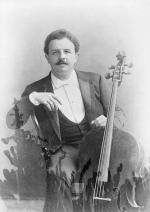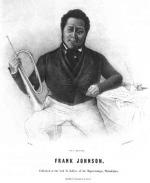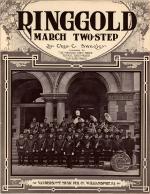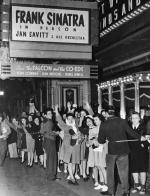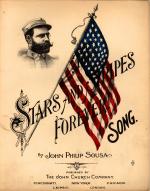Chapter 3: Popular Music
Music comes in many forms. Mothers' lullabies soothe their infants, work and marching songs revive aching muscles and rouse courage; hymns and chants fill places of worship with the holy vibrations of God's love and protection. Over the centuries different kinds of music have risen and fallen in popularity. Many of the folk songs brought from the Old World to the New were performed by generation after generation of Americans, and are still popular today. Opera and classical music, too, once filled concert halls with adoring and star-struck fans from all classes of society.
Into this great and varied outpouring of voice and instrument, something new emerged in the 1800s: music composed for a mass consumer market and distributed by the mass media; a commodity to be bought and sold like magazines or shoes. And it was America's emerging sheet music industry that created new opportunities for the writers, publishers, and sellers of songs.
The American marching band first came of age in the 1820s and 1830s. And the first of America's great popular bands was led by Philadelphian Frank Johnson, director of a brass band of professional musicians who made their living by performing for parades, military musters, civic celebrations, parties, and other occasions. Johnson and his band performed new marches, cotillions, waltzes, and other popular melodies, including some composed by Johnson himself. His ensemble also became the first band of American musicians to cross the ocean and carry American music to Europe, capping their triumphal British tour in 1838 with a performance for Queen Victoria.
Frank Johnson, director of a brass band of professional musicians who made their living by performing for parades, military musters, civic celebrations, parties, and other occasions. Johnson and his band performed new marches, cotillions, waltzes, and other popular melodies, including some composed by Johnson himself. His ensemble also became the first band of American musicians to cross the ocean and carry American music to Europe, capping their triumphal British tour in 1838 with a performance for Queen Victoria.
Most historians agree that the first American to make a living - or at least to attempt to make a living - by writing songs was Pittsburgh's Stephen Foster. In the 1840s and 1850s Foster composed a string of hits that were carried across the nation by minstrel shows, America's first home-grown form of musical theater, and by sheet music mass produced by steam-powered printing presses, then carried to market by steamboats and railroads. Foster's reign as America's most popular songwriter lasted less than a decade. In 1864 he would die broke in New York City at the age of thirty-seven. But the industry that Foster helped create continued to grow.
Stephen Foster. In the 1840s and 1850s Foster composed a string of hits that were carried across the nation by minstrel shows, America's first home-grown form of musical theater, and by sheet music mass produced by steam-powered printing presses, then carried to market by steamboats and railroads. Foster's reign as America's most popular songwriter lasted less than a decade. In 1864 he would die broke in New York City at the age of thirty-seven. But the industry that Foster helped create continued to grow.
Based in Manhattan's "Tin Pan Alley", the American sheet music industry was ever hungry for new songs. In the 1880s, African-American minstrel star James Bland became one of the nation's most popular, and its most prolific, songwriter. But like Foster, he, too, would die alone and forgotten. More successful was America's "March King", the great John Philip Sousa, whose Pennsylvania connections dated back to 1876, when he played violin in Offenbach's Orchestra during Philadelphia's Centennial Exposition. Sousa maintained those ties, performing with his world famous band each summer at the Willow Grove Amusement Park from the park's opening in 1896 until 1928.
James Bland became one of the nation's most popular, and its most prolific, songwriter. But like Foster, he, too, would die alone and forgotten. More successful was America's "March King", the great John Philip Sousa, whose Pennsylvania connections dated back to 1876, when he played violin in Offenbach's Orchestra during Philadelphia's Centennial Exposition. Sousa maintained those ties, performing with his world famous band each summer at the Willow Grove Amusement Park from the park's opening in 1896 until 1928.
For decades, sheet music shaped the sound of American popular music. Marketed to amateur musicians, pop music, like Sousa's great marches, had to be rhythmically steady and melodically straightforward. Americans loved a beautiful melody and virtuous lyrics, and for a short while no one wrote them better than Pittsburgh's Ethelbert Nevin. Trained as a concert pianist, Nevin made a meager living teaching music until the 1890s, when sales of his "art songs" brought him financial security and national celebrity. For years after his early death in 1900, his "The Rosary", "Narcissus" and "Mighty Lak" a Rose" were among the nation's best-known songs.
Ethelbert Nevin. Trained as a concert pianist, Nevin made a meager living teaching music until the 1890s, when sales of his "art songs" brought him financial security and national celebrity. For years after his early death in 1900, his "The Rosary", "Narcissus" and "Mighty Lak" a Rose" were among the nation's best-known songs.
For more than a century after Frank Johnson thrilled audiences with his marches and quadrilles, amateur musicians across the nation played together in local marching and concert bands. Pennsylvanians loved their bands, which for decades introduced the popular songs and latest musical styles to small towns across the Commonwealth. They also spawned local composers, none of whom was more prolific or eccentric than George Rosenkrans of Penfield, Pennsylvania. In close to half a century, Rosenkrans composed hundreds of marches, many of which he gave away or sold for less than a dollar.
George Rosenkrans of Penfield, Pennsylvania. In close to half a century, Rosenkrans composed hundreds of marches, many of which he gave away or sold for less than a dollar.
The great age of the American brass band and art song came to an end, however, with the arrival of the phonograph, radio, and "talking" pictures. What marvelous inventions! Thomas Edison may have invented the talking machine, but it was German-American inventor Emile Berliner who figured out how to produce limitless copies from a single master recording. Berliner introduced his "gramophone" to the world at Philadelphia's Franklin Institute in 1896.
Using Berliner's patents, the Victor Talking Machine Company in the early 1900s would become the nation's largest manufacturer of what the great Sousa -one of its early recording stars - pejoratively called "mechanical music". Soon "the tide of amateurism cannot but recede, until there will be left only the mechanical device and the professional executant," Sousa griped. "Then what of the national throat? Will it not weaken? What of the national chest? Will it not shrink?"
Will it not shrink?"
In fact, the nation's throat, chest - and legs - did quite well. Phonographs, radio, and motion pictures gave sound and sight to the many kingdoms of American popular music that could never be captured on the printed page; most notably a new form of rhythmically complex, improvised music then traveling up from the South, called "jazz". Once it arrived, Ethel Waters, Joe Venuti and
Joe Venuti and  Eddie Lang, the
Eddie Lang, the  Dorsey Brothers,
Dorsey Brothers,  Billy Eckstine,
Billy Eckstine,  Billy Strayhorn,
Billy Strayhorn,  John Coltrane, and other Pennsylvanians would help carry it forward, for it was a sound that had great appeal to the emerging mass consumer audiences who listened to the radio, flocked to nightclubs, and purchased phonograph records.
John Coltrane, and other Pennsylvanians would help carry it forward, for it was a sound that had great appeal to the emerging mass consumer audiences who listened to the radio, flocked to nightclubs, and purchased phonograph records.
In the late 1920s, the silent screen of the American motion picture industry burst into song. Now Hollywood could capture and mass-produce live theatrical and musical events, and bring them to movie theaters across the nation. After starring in one of the nation's first all-musical films, Fred Waring and his "Pennsylvanians" became one of the first musical groups to have its own nationally broadcast radio show. In the 1930s Philadelphians Frankie Richardson, Nelson Eddy, and Jeanette McDonald starred in Hollywood musicals that provided welcome moments of escape during the Great Depression. After World War II, the arrival of wide-screen Panorama and stereo sound made the movies even more lifelike. Now audiences could watch and listen to the great musicals of
Fred Waring and his "Pennsylvanians" became one of the first musical groups to have its own nationally broadcast radio show. In the 1930s Philadelphians Frankie Richardson, Nelson Eddy, and Jeanette McDonald starred in Hollywood musicals that provided welcome moments of escape during the Great Depression. After World War II, the arrival of wide-screen Panorama and stereo sound made the movies even more lifelike. Now audiences could watch and listen to the great musicals of  Oscar Hammerstein II, and women could swoon to the dazzling voice and the gorgeous face of South Philadelphia's
Oscar Hammerstein II, and women could swoon to the dazzling voice and the gorgeous face of South Philadelphia's  Mario Lanza.
Mario Lanza.
After World War II, America entered an age of unprecedented prosperity and rapid technological innovation, and its mass consumer industries grew as never before. Magnetic audio tape and vinyl enabled the popular music industry to offer new, "hi-fidelity" 45 rpm "singles" and long-playing 33 rpm albums. In 1951, Alan Freed, a young radio "disc jockey" born in Johnstown, began to spin vinyl records of a new kind of youth music he was perhaps the first to call "rock and roll". Six years later American Bandstand turned local acts, including Danny and the Juniors, Frankie Avalon, Chubby Checker, and Fabian into "teen idols", and brought the Twist, the Watusi, and other dances of Philadelphia teenagers into homes across the nation.
American Bandstand turned local acts, including Danny and the Juniors, Frankie Avalon, Chubby Checker, and Fabian into "teen idols", and brought the Twist, the Watusi, and other dances of Philadelphia teenagers into homes across the nation.
The arrival of talking pictures in the late 1920s had spelled the end of vaudeville, which lost its stars and its audiences to the motion picture industry. It also created opportunities for composers and tunesmiths like Mahanoy City's Victor Schertzinger, who after writing the first scores for silent pictures went on to direct as well as compose for Hollywood musicals in the 1930s. In the 1950s television drew away audiences and money from radio and films. During World War II, big band leader
Victor Schertzinger, who after writing the first scores for silent pictures went on to direct as well as compose for Hollywood musicals in the 1930s. In the 1950s television drew away audiences and money from radio and films. During World War II, big band leader  Les Brown had enjoyed a string of hit songs, adored by GI's and their loved ones back home. When big bands lost their audiences after the war,Brown found a new gig, which supported him for decades, as comedian Bob Hope's music director on radio and television, and during his celebrated USO tours.
Les Brown had enjoyed a string of hit songs, adored by GI's and their loved ones back home. When big bands lost their audiences after the war,Brown found a new gig, which supported him for decades, as comedian Bob Hope's music director on radio and television, and during his celebrated USO tours.
As sitcoms, action adventure serials, soap operas, and advertising jingles migrated from radio and Saturday afternoon movie matinees to the "boob tube" in the family den, so too, did the music that accompanied them. Like many composers of his generation, Jay Livingston made the leap from Tin Pan Alley to Hollywood and then television. The winner of three Academy awards, Livingston's best-known music may well be the theme song for "Mr. Ed", the beloved 1960s sitcom about a talking horse.
Jay Livingston made the leap from Tin Pan Alley to Hollywood and then television. The winner of three Academy awards, Livingston's best-known music may well be the theme song for "Mr. Ed", the beloved 1960s sitcom about a talking horse.
Pennsylvania would continue to produce great songwriters and pop stars. In the 1970s, for example, Kenny Gamble and Leon Huff's sophisticated orchestrations and the voices of Patti LaBelle and Teddy Pendergast would make Philadelphia the center of a soulful and sophisticated rhythm and blues, known as the "Sound of Philadelphia", that achieved international popularity. Today, American popular music is a multi-billion dollar industry with vast and still growing international appeal. In bedrooms and garages, high school auditoriums and convention centers, home recording studios and state-of-the-art facilities, on street corners and in town squares across the Commonwealth, Pennsylvanians continue to exercise their throats, chests, legs, and fingers in the creation of popular song and dance.
Today, the ongoing digital revolution is bringing about yet another transformation in American popular music as profound as those wrought by the arrival of the steam-driven printing presses of the 1800s, and electrical mass media of the early 1900s. Digital media are fueling yet another wave of opportunity and creativity, making it possible for people with limited means to record, reproduce, and distribute their music to audiences across the Commonwealth and the globe.
Into this great and varied outpouring of voice and instrument, something new emerged in the 1800s: music composed for a mass consumer market and distributed by the mass media; a commodity to be bought and sold like magazines or shoes. And it was America's emerging sheet music industry that created new opportunities for the writers, publishers, and sellers of songs.
The American marching band first came of age in the 1820s and 1830s. And the first of America's great popular bands was led by Philadelphian
Most historians agree that the first American to make a living - or at least to attempt to make a living - by writing songs was Pittsburgh's
Based in Manhattan's "Tin Pan Alley", the American sheet music industry was ever hungry for new songs. In the 1880s, African-American minstrel star
For decades, sheet music shaped the sound of American popular music. Marketed to amateur musicians, pop music, like Sousa's great marches, had to be rhythmically steady and melodically straightforward. Americans loved a beautiful melody and virtuous lyrics, and for a short while no one wrote them better than Pittsburgh's
For more than a century after Frank Johnson thrilled audiences with his marches and quadrilles, amateur musicians across the nation played together in local marching and concert bands. Pennsylvanians loved their bands, which for decades introduced the popular songs and latest musical styles to small towns across the Commonwealth. They also spawned local composers, none of whom was more prolific or eccentric than
The great age of the American brass band and art song came to an end, however, with the arrival of the phonograph, radio, and "talking" pictures. What marvelous inventions! Thomas Edison may have invented the talking machine, but it was German-American inventor Emile Berliner who figured out how to produce limitless copies from a single master recording. Berliner introduced his "gramophone" to the world at Philadelphia's Franklin Institute in 1896.
Using Berliner's patents, the Victor Talking Machine Company in the early 1900s would become the nation's largest manufacturer of what the great Sousa -one of its early recording stars - pejoratively called "mechanical music". Soon "the tide of amateurism cannot but recede, until there will be left only the mechanical device and the professional executant," Sousa griped. "Then what of the national throat? Will it not weaken? What of the national chest?
In fact, the nation's throat, chest - and legs - did quite well. Phonographs, radio, and motion pictures gave sound and sight to the many kingdoms of American popular music that could never be captured on the printed page; most notably a new form of rhythmically complex, improvised music then traveling up from the South, called "jazz". Once it arrived, Ethel Waters,
In the late 1920s, the silent screen of the American motion picture industry burst into song. Now Hollywood could capture and mass-produce live theatrical and musical events, and bring them to movie theaters across the nation. After starring in one of the nation's first all-musical films,
After World War II, America entered an age of unprecedented prosperity and rapid technological innovation, and its mass consumer industries grew as never before. Magnetic audio tape and vinyl enabled the popular music industry to offer new, "hi-fidelity" 45 rpm "singles" and long-playing 33 rpm albums. In 1951, Alan Freed, a young radio "disc jockey" born in Johnstown, began to spin vinyl records of a new kind of youth music he was perhaps the first to call "rock and roll". Six years later
The arrival of talking pictures in the late 1920s had spelled the end of vaudeville, which lost its stars and its audiences to the motion picture industry. It also created opportunities for composers and tunesmiths like Mahanoy City's
As sitcoms, action adventure serials, soap operas, and advertising jingles migrated from radio and Saturday afternoon movie matinees to the "boob tube" in the family den, so too, did the music that accompanied them. Like many composers of his generation,
Pennsylvania would continue to produce great songwriters and pop stars. In the 1970s, for example, Kenny Gamble and Leon Huff's sophisticated orchestrations and the voices of Patti LaBelle and Teddy Pendergast would make Philadelphia the center of a soulful and sophisticated rhythm and blues, known as the "Sound of Philadelphia", that achieved international popularity. Today, American popular music is a multi-billion dollar industry with vast and still growing international appeal. In bedrooms and garages, high school auditoriums and convention centers, home recording studios and state-of-the-art facilities, on street corners and in town squares across the Commonwealth, Pennsylvanians continue to exercise their throats, chests, legs, and fingers in the creation of popular song and dance.
Today, the ongoing digital revolution is bringing about yet another transformation in American popular music as profound as those wrought by the arrival of the steam-driven printing presses of the 1800s, and electrical mass media of the early 1900s. Digital media are fueling yet another wave of opportunity and creativity, making it possible for people with limited means to record, reproduce, and distribute their music to audiences across the Commonwealth and the globe.







